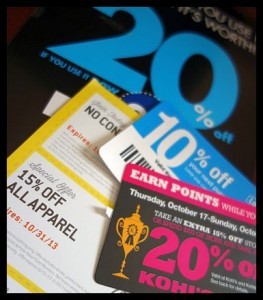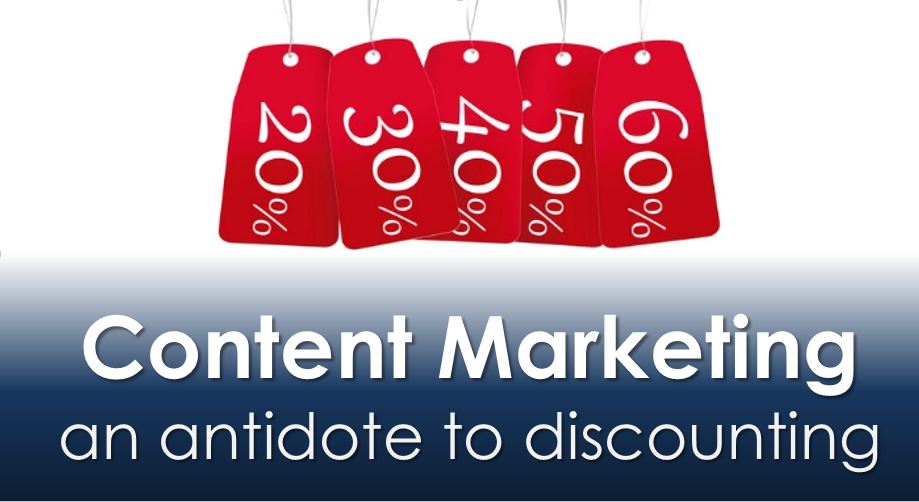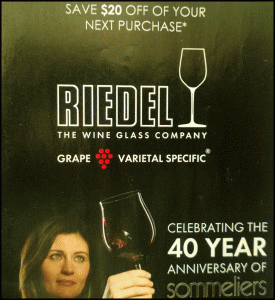Flying back from San Francisco, I open the in-flight magazine and a half-page ad by Riedel catches my eye. Riedel a German company and one of the best known manufacturers of high quality wine glasses.
It is a premium brand: a pair of wine glasses especially designed for Cabernet and Merlot retails for about $50. Their customers are either wine enthusiasts or people with a lot of money who don’t mind spending $25 for a wine glass.
It is a nice looking ad, but I was surprised to see the ad’s main message is an offer of 20% discount for a purchase of $100 or more. It does not seem to fit the brand. At the same time, it was not that surprising to see a discount oriented message: it is the easy answer. ‘What should be the message? I know, let’s offer a 20% discount’
When a marketer’s creativity runs out he defaults back to price discounts.
Here is why I suggest discounting it is the wrong strategy for Riedel
- Discounting erodes Riedel’s position as a premium brand
- The discount is only redeemable at Riedel.com ignoring and/or undermining their channel strategy that includes local retailer like Macys and online retailers like Amazon
- A 20% discount reduces the overall profitability of a sale by probably 40 to 50%, even as a premium brand
- You may say this is an offer to get customers who have never bought a Riedel to buy their first one, but It is unlikely I will want to start spending $80 on wine glasses based on finding a coupon code (minimum purchase is $100)
- The continued practice of providing discount codes and coupons trains customers to only buy with a discount. Anyone who shops at Kohl’s or Bed Bath and Beyond can tell you shopping at these stores without a coupon is overpaying.
- The discount is only valuable for customers who already have a predisposition to buy the product: customers who already now Riedel and believe it is a good investment to buy their products. Customers who were likely to buy anyway. For the rest of us, the discount is irrelevant as we were not planning on spending $100 on wine glasses.
If discounting is the lazy answer, what would be a better strategy for a premium brand like Riedel? Content Marketing.
After all, Modern marketing is about being helpful and educating your customers.
As someone who enjoys wine and appreciates quality products (although I am not sure I want to spend $50 on a pair of wine glasses), I imagine most wine enthusiasts would be interested in learning what kind of glasses are the right ones for each kind of wine and the effect of a good glass in the enjoyment of wine.
While most wine drinkers know there are different glasses for red and white wine (and for champagne and whiskey), until I did some research today I had no clue there were different glasses for drinking Cabernet than for drinking other kinds of wine.
Behavioral psychology has taught us that it really does not matter if the type of glass has a material effect on the actual taste. It is enough for someone to believe it for your brain to register increased enjoyment while drinking on the right kind of glass. And as the story The Emperor has No Clothes taught us, it may be enough for the host to share how special the glasses are to get everyone at the party to believe wine will taste better in a Riedel glass made specifically to enhance enjoyment of a good bottle of Cabernet Sauvignon.

Getting back to the ad, imagine if , instead of a discount that assumes I am interested in buying their product, Riedel offered a guide to enjoying wine: a booklet in the mail or an eBook that educates customers on the properties of the different types of wines, the need for different types of glasses, how their different properties influence taste of different wines, and some history of quality lead-based glass made in Germany and the craftsmanship that goes into their products. The killer is Riedel already has this content.
This kind of content would be attractive to a large percentage of wine enthusiasts and would have a high probability of converting more than a few of them into loyal Riedel customers who brag about their unique glasses next time they are hosting guests at home, spreading the message. After all, you can’t love a product until you get to know it – that’s the key point of one of my recent posts. Reading tweets about the brand shows how this strategy would fit their overall educational strategy very well.
There are times when a discounting strategy works very well: WalMart, Joseph A. Bank and the last few years at JC Penney (who tried a strategy of everyday low prices instead of discounts) have proven that there are markets and brands for which discounting works well. Discounting is often the only strategy that works when selling a commodity product – or at least when you think your product is a commodity.
When your value prop is a discount, you are making your product a commodity – look at the picture of the coupons I got in the mail recently: there is no expression of value other than the discount. I encourage you to think about how you can be helpful and how can you educate your customers, avoiding the trap of discounting and helping them fall in love with your product, making them want to buy it because of its unique properties, not because of the latest discount or promotion.


